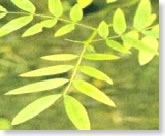
SVARNA PARTI
Botanical Name: Cassia angustifolia ( CAESALPINOIDEAE)
English Name: Indian Senna, Tinnevelly Senna, Cassia Senna
Hindi Name: Sunamkhi

Introduction: Senna is also known by the names Alexandrian Senna and Rajavriksha. Cassia senna is native to tropical Africa, and is cultivated in Egypt and the Sudan; Cassia angustifolia is native to India, and is cultivated mainly in India and Pakistan. Both the leaves and pods are used in many over the counter pharmaceutical preparations. People in northern Africa and southwestern Asia have used Senna as a natural laxative for centuries. It was considered a “cleansing” herb because of its cathartic effect. In addition, the leaves were sometimes made into a paste, and applied to various skin diseases. Acne & ringworm were both treated in this way. Senna is a powerful cathartic used primarily in the treatment of constipation, working through a stimulation of intestinal peristalsis.
Distribution: A small shrub, about 1m in height with pale subterete or obtusely angled erect or ascending branches. Found throughout India upto 4500 feet in the hills. Cultivated in gardens mainly. Cultivated in dry lands of Southern & Western India, and indigenous to Arabia.
Chemical Constituents: anthraquinone glycosides (sennosides, aloe-emodin, rhein), beta-sitosterol, flavones, tartaric acid, mucin, essential oil, mucilage, tannin, resin etc.
Parts Used: Pods, stems, leaves.
Properties: bitter, digestive, laxative, antimicrobial etc.
Indications: Constipation, inflammatory skin conditions, hypertension, obesity etc.
Dose:
Therapeutic Uses:
- Laxative: 1-2g of powder is mixed with jaggary and given orally.
- Acne & ringworm: Leaf paste applied externally will be useful.
Scientific Studies:
It is recognised by British and US pharmacopoeias. It is useful in habitual costiveness. It lowers bowels, increases peristaltic movements of the colon by its local action upon the intestinal wall. It is used as expectorant, wound dresser, antidysentric, carminative and laxative.
The active principle of Senna was first isolated and characterized by Stoll in 1941. The first two glycosides were identified and attributed to the anthraquinone family. These were found to be dimeric products of aloe emodin and/ or rhein which were named sennoside A and sennoside B. They both hydrolyze to give the aglycones sennidin A and B and two molecules of glucose. Later work confirmed these findings and further demonstrated the presence of sennodides C and D. Small quantities of monomeric glycosides and free anthraquinones seem to be present as well. The active constituents of the pods are similar to those of the leaves but present in larger quantities. Two naphthalene glycosides isolated form seena leaves and pods are 6-hydroxymusicin glucoside and tinnevellin glucoside. Both compounds can be utilized to distinguish between the Alexandrian senna and the India senna, since tinnevellin glucoside is only found in the latter and the first only in the C.senna (Franz G. Pharmacology. 1993 Oct; 47 suppl 1:2-6).
Cultivation Technology: Red loams including coarse gravelly soils or alluvial loams and even rich clave rice fields with PH between 7-8.5 are suitable. 2 kg seeds are required per acre. Sown between Jan-Feb or June-July. Sown in fields directly or transplanted 15-20 days after sowing.
Harvesting: First harvesting of leaves and pods after 90 days. Subsequent two harvests will be at an interval of 30-35 days.







